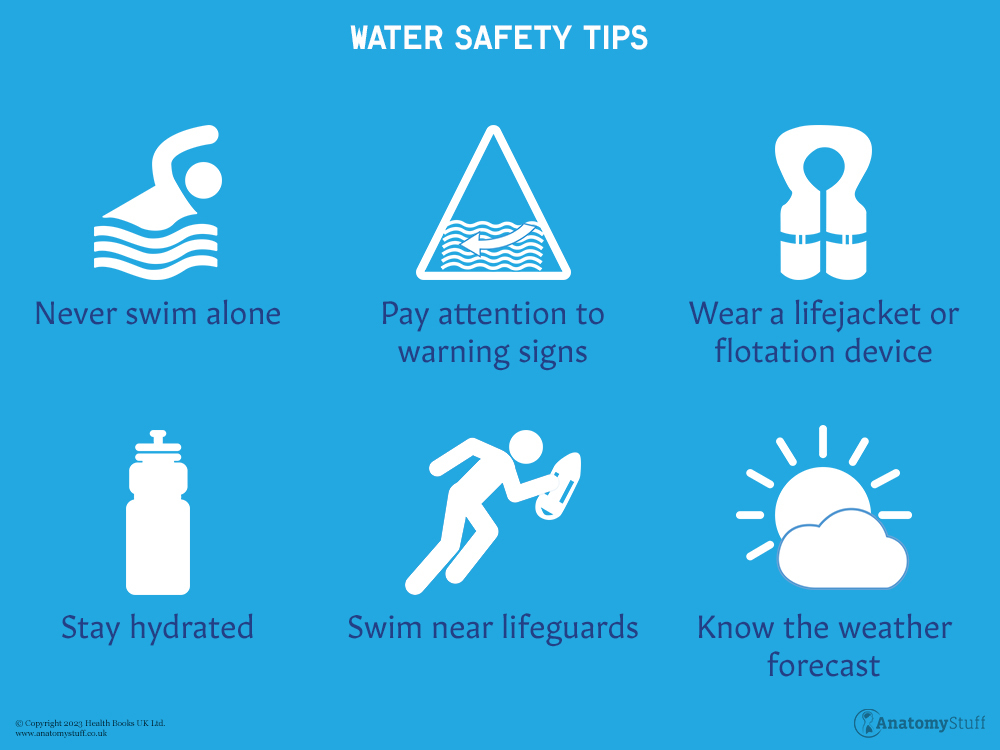
Water safety refers to the measures and practices put in place to ensure the safety of individuals when they are in or around the sea, such as beaches, coastal areas, or when engaged in water-related activities. It encompasses various aspects, including personal safety, boating safety, beach safety, and general water safety.
• Always try to swim with others and never alone – that way, if you get into difficulty, you have people to help.
• Ensure you are a strong swimmer before entering deep waters but remember, even the strongest swimmers can get into difficulty, so ensure you are well prepared and swim near lifeguards.
• Be aware of the location of the nearest lifebuoy ring in case of emergency. These are usually located on the deck of boats and alongside areas of deep water.
• Swim within your depth and swim parallel to the shore.
• Swim in designated areas.
• Try to stay within familiar waters, and if you do enter a new water area, ask local lifeguards for advice about any hazards or hidden dangers.
• Be aware of currents and learn about the currents in the area where you plan to swim. Strong ocean currents, such as rip currents, can be dangerous. If caught in a rip current, swim parallel to the shore until you escape its pull, then swim back to land.
• Pay attention to warning signs or flags posted at the beach. These signs provide important information about water conditions, such as high surf, strong currents, or hazardous marine life. Always follow the instructions and advice provided.
• Wear a lifejacket or flotation device with the correct fitting straps when boating onboard a boat.
• Wear suitable clothing, such as a wetsuit.
• Know the weather forecast and the tides.
• Never jump or dive in in case of hidden hazards like rocks under the water.
• Never swim when you are hot or tired.

Remember to stay well hydrated, especially in warm weather. Don’t swim while on medications that make you drowsy or with alcohol taken. Always bring your mobile phone and be sun smart –pile on your sun cream as you can burn in the water too!
Remember, the sea can be unpredictable, so always use caution, common sense, and good judgment while enjoying water activities.
Sadly, too many children die each year in home accidents involving water, pools, and ponds.
Remember, drowning can occur in very shallow water, in such places as streams, drains at the end of a garden, fish or garden pond, paddling and swimming pools, wells, barrels or water tanks, septic tanks or slurry pits.
• Fence off any rivers, drains, or streams running near your home.
• Empty paddling pools and baths immediately after use
• Close off open drains, wells, and any other kind of opening a child could fall into.
• If you have a private pool, ensure it is fenced-in and not accessible to children without your supervision.
• Cover pools with secure covers if you can’t empty them.
• If you live on a farm, keep children away from slurry pits.
• Rain barrels, water tanks, wells and fishponds should be covered with wire mesh or metal grids.
• Ensure pets are adequately catered for during warm weather.
Remember, water safety is of utmost importance to protect yourself and others. Always prioritise caution, awareness, and adherence to safety guidelines to have a safe and enjoyable experience in and around the water. To find out more about sea safety please visit the RNLI’s webiste.